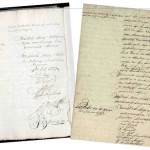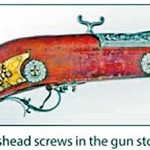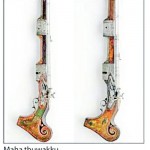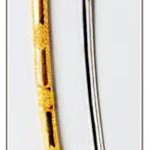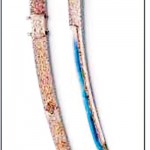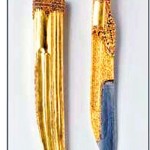News
Netherlands to return priceless artefacts seized from Kirti Sri Rajasinha’s palace in 1765
View(s):- The booty from the Dutch-Kandyan Wars have been exhibited in Rijksmuseum in Amsterdam from almost the mid18th Century
- Joint research between Dutch and local scholars seen as a landmark in Sri Lankan provenance studies
By Yomal Senerath-Yapa
Booty from the Dutch-Kandyan Wars, seized from the palace of King Kirti Sri Rajasinha in 1765 in Kandy, the artefacts are priceless.
According to the Government of the Netherlands the ‘wrongfully brought’ objects, ‘acquired under duress or by looting’ would be transferred officially at the National Museum of Ethnology in Leiden on 10 July while the objects themselves will be flown back later this year.
- Sri Lanka National Archives document regarding “Leuwke’s Cannon” (pictured above) that it was stolen from Kandy Dutch colonialists. The Department shared the proof of a letter signed by then Dutch Governor in his own words saying: ‘een klein stukje kanon, in Kandia veroverd’ (a small piece of cannon, captured in Kandy). The letter was signed on November 12, 1765, and sent to Holland. The document can be accessed at the official website of the National Archives of the Netherlands.
- The Lewke cannon, gifted by the Lewke Dissawe to the king then looted by the Dutch, will be returned this year
It was last year that Sri Lanka and Indonesia requested the return of a number of objects that are “of great importance to the two countries”.
The government issued a statement that “the decision to return them was made by Secretary of State for Culture and Media Gunay Uslu, following the recommendations of the Advisory Committee on the Return of Cultural Objects from Colonial Context, chaired by Lilian Gonçalves-Ho Kang You. The works are currently in the collections of the National Museum of World Cultures and the Rijksmuseum.”
State secretary Usulu said, “This is a historic moment. It’s the first time we’re following recommendations of the Committee to give back objects that should never have been brought to the Netherlands. But more than anything, it’s a moment to look to the future. We’re not only returning objects; we’re also embarking on a period of closer cooperation with Indonesia and Sri Lanka in areas like collection research, presentation and exchanges between museums.”
Indonesia, who had also requested the recovery of their treasures seized, will be given back the ‘Lombok treasure’, consisting of 335 objects from Lombok, four statues from Singasari, a keris from Klungkung and 132 objects of modern art from Bali, known as the Pita Maha collection. Altogether 478 objects would be repatriated to the two countries.
The Dutch government added that their researchers worked closely with Indonesian and Sri Lankan counterparts to ascertain provenance.
The provenance research has confirmed that the golden kastane, embellished with 136 diamonds and 13 rubies, was a personal belonging of Kirti Sri Rajasinha- though till 1957 attributed to Java. The silver kastane, again credited to the mainland of Southeast Asia, is most probably a Kandyan nobleman’s property.
Once called a ‘Malay dagger’ the Sinhalese knife, with crystal hilt decorated with gold and a wooden sheath entirely overlaid with gold, must have formed part of the royal garb.
The wall guns, or mahatuwakku, represent a unique, early Sri Lankan tradition of gun-making and warfare. A flintlock (called Bondikula) fitted on the left side with an external safety catch and a cross head screw make the guns endemic.
The baroque cannon, made in Batavia, has colourful motifs such as liyawel, kalpa vruksha and nari lata on the medieval blue was gifted to the king by the Lewke Dissawe (a nobleman).
The Sri Lankan researchers who took part in the study were Additional Director General (cultural) Department of National Museums Senarath Wickremesinghe, academics Prof. Asoka de Zoysa and Dr. Ganga Dissanayake and firearms specialist Chamikara Pilapitiya.
Meanwhile the Ministry of Buddhasasana, Religious and Cultural Affairs stated the cabinet has appointed a local advisory committee on the return of artefacts.
Said Ms. Sanuja Kasthuriarachchi, Director General of the Department of National Museums, “The laborious provenance research has led to the dispelling of any myths and ambiguities that shrouded our Kandyan artefacts (at Rijksmuseum) for centuries. It is heartening to see these cultural symbols which mirror the cleverness of Sri Lankan artisans of yesteryear, reclaiming their due pride of place in their land of birth.”
It was reiterated that the joint research between Dutch and local scholars was “a landmark in Sri Lankan provenance studies” as “very little notice was taken of the Kandyan objects in discussion (hitherto)…”
The Dutch Advisory Committee on the Return of Cultural Objects from Colonial Context is now considering further requests from Indonesia, Sri Lanka and Nigeria and will issue its recommendations on these requests later.
The best way to say that you found the home of your dreams is by finding it on Hitad.lk. We have listings for apartments for sale or rent in Sri Lanka, no matter what locale you're looking for! Whether you live in Colombo, Galle, Kandy, Matara, Jaffna and more - we've got them all!


